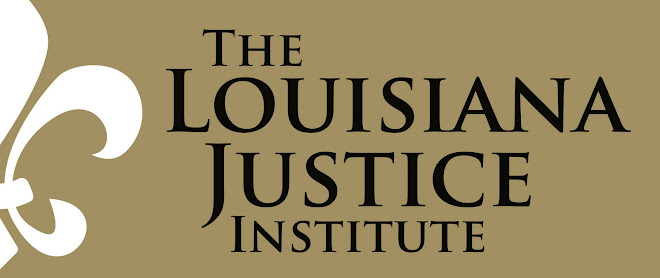 As we enter the final days before New Orleans' historic municipal elections, Louisiana Justice Institute presents excerpts from Race, Representation, and Recovery: Documenting the 2006 New Orleans Mayoral Elections, by Katherine Cecil. We believe her analysis of the 2006 elections forms an important basis for understanding the current election.
As we enter the final days before New Orleans' historic municipal elections, Louisiana Justice Institute presents excerpts from Race, Representation, and Recovery: Documenting the 2006 New Orleans Mayoral Elections, by Katherine Cecil. We believe her analysis of the 2006 elections forms an important basis for understanding the current election.In 2006, twenty-nine years after Moon Landrieu had left office, the pattern of coalition building looked as if it might radically change. The 2006 Primary election involved an inordinate number of challengers to Nagin’s re-election bid, and these twenty-three challengers reinforced the idea that to many white election observers, this election would be a referendum on the incumbent’s leadership skills as tested during hurricane Katrina. However to many African-American election observers and to Nagin’s chief campaign manager, the veteran political strategist Jim Carvin, the large number of white candidates running constituted a continuation of a re-assertion of narrow racial interests first signaled by the moneyed class within the white community in the early days following Katrina. Concerning this economically influential group that had backed Nagin in 2002, Carvin said, “They were delusional. They thought that they could re-capture City Hall, and I’m really talking about the moneyed class in New Orleans. They felt that Nagin was so crippled that he could not win.”
In the months following the storm, numerous articles and essays began to appear on the Internet referencing conspiracies to whiten New Orleans, and many attested to these as “real and substantial fears.” National print and online media reported talk of a “new” New Orleans which had began to surface within conversations amongst the largely white, wealthy, and Uptown populations that had returned to the city for the most part unscathed. Combined with the stark shift in New Orleans demographics, it was therefore little wonder that within the months following the storm locals would also witness the fracturing of a more inclusive rebuilding rhetoric, and this had fundamental implications upon how the 2006 elections played out. These less than inclusive interests at the hands of a hitherto white minority had been voiced in the early days after Hurricane Katrina, within a series of closed-door meetings in Dallas and Houston in which the meetings’ organizers had done little to reach out to prominent African-American officials in exile, and one of these meetings was widely publicized by print and online media outlets after the fact.
The most written about example of these sentiments was Christopher Cooper’s Wall Street Journal article titled “Old-Line Families Escape Worst of Flood And Plot the Future,” where Cooper quotes former Nagin supporter and Regional Transit Authority head James Reiss:
The new city must be something very different, Mr. Reiss says, with better services and fewer poor people. "Those who want to see this city rebuilt want to see it done in a completely different way: demographically, geographically and politically," he says. "I'm not just speaking for myself here. The way we've been living is not going to happen again, or we're out."Reiss was Chairman of the majority white New Orleans Business Council and before moving into the world of money management and real estate he ran a lucrative automation and control systems manufacturer called TANO Corp for thirty years, and is defined by many sources as the archetypal old-line Uptown New Orleanian with downtown business interests; successful, well-connected, influential, and powerful behind the scenes of several mayoral campaigns, including Mayor Nagin’s 2002 election run.
The sentiments reported by Cooper in the WSJ article were in some shape or form shared by a significant number of prominent white citizens. Whether due to the dramatic alterations in racial demographics resulting from Hurricane Katrina, the outrage felt by vocal white citizens following the ineptitude of early disaster recovery, or as a mark of outright opportunism, the 2006 Mayoral Election involved an unprecedented number of white candidates qualifying. This factor had particularly interesting significance due to a trend noted by political scientists that “the historic pattern among New Orleans mayoral elections [is that] black mayoral candidates receive a majority of the vote cast by whites only in the absence of a viable white contender.”
Taking little account of the concerns of the predominantly African-American Diaspora, such opinions were first vocalized by prominent men within the white business community, and were then further voiced by the early rebuilding plans of the Bring New Orleans Back Commission (BNOBC), a body primarily made up of citizens appointed by Mayor Nagin before it had become apparent that he had lost support from within the white conservative community. Nagin had established the BNOBC following Katrina, and its purpose was to “finalize a master plan to advise, assist and plan the direct funding on the rebuilding of New Orleans.” The BNOBC’s mission statement specified its goal as directed “uniquely for every citizen;” however, the most controversial aspects of the plan did not represent the interests of those who had suffered most during the flooding.
(You can read the complete essay online here.)
Born in the UK, and living in New Orleans since 2001, Katherine Cecil began her film career as a researcher and field producer. She formed her small company CecilFilm Productions shortly after Hurricane Katrina, and is currently working as a co-producer on a documentary looking into recent changes to the New Orleans public school system.

No comments:
Post a Comment